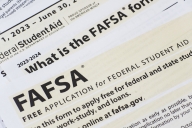You have /5 articles left.
Sign up for a free account or log in.

High school students left $3.75 billion in Pell Grant funding on the table in 2021.
designer491/Getty Images
Several years after Louisiana became the first state to require public high school students to complete the Free Application for Federal Student Aid before they graduate, a dozen other states have implemented or are considering similar measures.
Legislators in Florida, Hawaii, Indiana, Nebraska, New York and South Carolina are this session looking at potential policies that would require public high school students to complete the federal aid application or deliberately opt out of the mandate. Advocates of such policies believe they help show students that college can be affordable and that the barriers to access higher education might not be as formidable as they thought.
Lawmakers see FAFSA mandates as “actionable, low-hanging fruit,” said Sunny Deye, program director for postsecondary education at the National Conference of State Legislatures.
“It’s been a slow trickle” of states warming to the idea, Deye said. “They invest so much in their financial aid programs, and they want to make sure that eligible students in their state receive aid.”
In total, the public high school Class of 2021 left an estimated $3.75 billion in Pell Grants on the table, according to a recent report from the National College Attainment Network. Between 2017 and 2021, the estimated amount of unclaimed Pell Grant dollars increased by 60 percent.
The number of high school students who complete the FAFSA is declining nationwide. In 2021, 54 percent of high school graduates filled out the aid form, compared with 61 percent in 2017, the NCAN report showed.
Meanwhile, the FAFSA completion rate in Louisiana has increased, thanks to the state’s graduation requirement, said Peter Granville, a senior policy associate at the Century Foundation who studies FAFSA requirement policies. In its first year, FAFSA completion rates among 12th graders increased by 10 percentage points. (This paragraph has been updated to clarify the increase in Louisiana's FAFSA completion rate.)
“Under Louisiana’s policy, poor students were finally completing the FAFSA at the same rate as richer students,” Granville said. “One of the most important trends in FAFSA completion over all is that students who need aid to afford college are less likely to apply than those who don’t need the aid. But under Louisiana’s policy, that gap vanished within a remarkably short time.”
In 2021, Louisiana had the second-highest FAFSA completion rate in the country—behind Tennessee—at 68 percent.
The most popular FAFSA mandate models require students to fill out the federal aid form prior to graduating high school or require the student or their parents to submit a waiver that clearly shows they’ve declined to apply for the aid.
That’s the model that the Indiana Legislature is working with this session. This is the fourth time the Legislature is considering a bill on FAFSA requirements, said Josh Garrison, associate commissioner at the Indiana Commission for Higher Education. Previous iterations of the bill failed for a variety of reasons, but he hopes the generous opt-out clause will help the bill succeed.
“This isn’t really something that can wait another year,” Garrison said. “We’re seeing enrollment declines. We’re seeing our low-income students being left behind. We’re seeing our rural students being left behind. We’re seeing our Black and brown students being left behind.”
Students in Indiana left $65.2 million Pell Grant dollars unclaimed in 2021, according to the NCAN report.
The New York Senate and Assembly are also considering a FAFSA requirement bill this year. State Senator Andrew Gounardes, author of the Senate version of the bill, hopes that a FAFSA completion requirement will help more high school graduates see that college is within reach.
“Sometimes this little paperwork is all it takes to make or break someone’s decision to take the next step in their career or their life,” Gounardes said. “I’m really excited about the prospect of trying to pass this, because I think it’ll have a big impact on students.”
Colorado, which passed a FAFSA completion law last year, uses a slightly different model than other states. Instead of a statewide requirement, the state government offers grants to school districts that decide to enforce FAFSA completion.
“I imagine school districts are happier to have the liberty to opt out of the requirement if they choose,” Granville, of the Century Foundation, said. “I think an essential piece of making a policy like this successful is new money from the state government to help schools walk students and families through it.”
FAFSA requirement policies are already in place in three of the nation’s most populous states: California, Illinois and Texas. Granville expects the trend to continue in the coming years.
“By the end of this year, one in three of the nation’s public school 12th graders will be subject to a FAFSA graduation requirement,” Granville said. “I expect it’ll keep growing in the years to come.”








